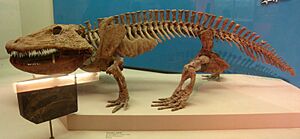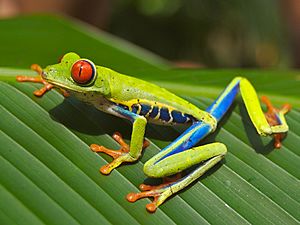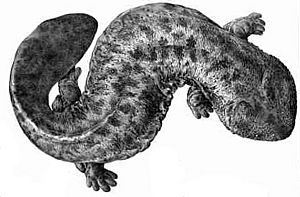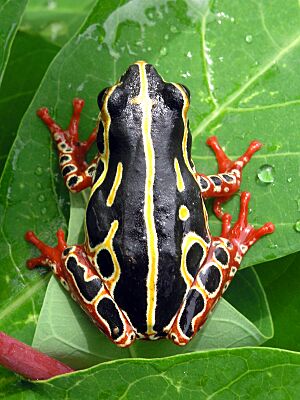List of amphibians facts for kids




Amphibians are amazing animals that can live in many different places! They are ectotherms, which means their body temperature changes with their surroundings, just like reptiles. They are also tetrapods, meaning they have four limbs, and they are vertebrates, which means they have a backbone. All living amphibians belong to a group called Amphibia.
Most amphibians start their lives as larvae (like tadpoles) living in water. But as they grow, they change and can often live on land. Some clever amphibians have even found ways to skip the water stage completely!
Scientists organize amphibians into different groups called families and subfamilies. This helps us understand how they are related. One important list of amphibians is called Amphibian Species of the World by Darrel Frost. Another helpful list is from AmphibiaWeb. Sometimes these lists group animals slightly differently, but they both help us learn about these cool creatures.
All About Amphibians: Frogs, Salamanders, and Caecilians
There are over 8,200 different kinds of amphibians known around the world! They are divided into three main groups, called orders.
Order Anura: Frogs and Toads
As of August 29, 2020, there are 7,243 known species of frogs and toads. These are probably the most well-known amphibians! They are famous for their jumping, croaking, and often their sticky tongues.
Ancient Frogs (Archaeobatrachia)
This group includes some of the oldest types of frogs.
- Family Alytidae – These are called painted frogs or disc-tongued frogs. There are 12 species.
- Family Bombinatoridae – Known as firebelly toads, there are 8 species. They often have bright colors on their bellies to warn predators.
- Family Leiopelmatidae – These are New Zealand primitive frogs, with 3 species.
- Family Ascaphidae – Called tailed frogs, there are 2 species. Male tailed frogs have a unique tail-like structure.
Middle Frogs (Mesobatrachia)
This group includes frogs that are a bit more modern than the ancient ones.
- Family Megophryidae – These are litter frogs or short-legged toads, with 268 species. They often blend in with leaves on the forest floor.
- Family Pelobatidae – European spadefoot toads, 6 species. They use a special "spade" on their feet to dig.
- Family Pipidae – These are tongueless frogs, with 41 species. They live mostly in water and use their hands to grab food.
- Family Rhinophrynidae – The Mexican burrowing toad, with only 1 species. It's a round frog that digs backwards into the soil.
- Family Scaphiopodidae – American spadefoot toads, 7 species. Like their European cousins, they are great at digging.
New Frogs (Neobatrachia)
This is the largest group of frogs and toads, with many different kinds!
- Family Arthroleptidae – Called screeching frogs or squeakers, there are 149 species.
- Family Brevicipitidae – These are small, round frogs, with 36 species.
- Family Bufonidae – These are the true toads, with 627 species. Many have warty skin.
- Family Centrolenidae – Known as glass frogs, there are 156 species. Some have skin so clear you can see their insides!
- Family Dendrobatidae – These are the famous poison dart frogs, with 200 species. Their bright colors warn predators they are toxic.
- Family Hylidae – These are the tree frogs, with 1,036 species. They have special pads on their toes to help them climb.
- Family Hyperoliidae – Sedge frogs or bush frogs, with 228 species. They are often found in grassy areas.
- Family Leptodactylidae – Southern frogs or tropical frogs, with 219 species.
- Family Mantellidae – These frogs are found in Madagascar, with 231 species.
- Family Microhylidae – Called narrow-mouthed frogs, there are 698 species. They often eat ants and termites.
- Family Myobatrachidae – Australian ground frogs, 85 species.
- Family Ranidae – These are the true frogs, with 409 species. This is a very common group of frogs.
- Family Rhacophoridae – Known as moss frogs, with 430 species. Some can "fly" or glide using webbed feet.
Order Caudata: Salamanders
As of August 29, 2020, there are 759 known species of salamanders. Salamanders look a bit like lizards, but their skin is smooth and moist, not scaly.
Hidden Gill Salamanders (Cryptobranchoidea)
This group includes some of the most primitive salamanders.
- Family Cryptobranchidae – These are giant salamanders, with 4 species. They are the largest living amphibians.
- Family Hynobiidae – Asiatic salamanders, with 81 species. They are found across Asia.
New Salamanders (Salamandroidea)
This is the largest group of salamanders.
- Family Ambystomatidae – Called mole salamanders, there are 37 species. They spend much of their lives underground.
- Family Amphiumidae – Amphiumas or Congo eels, 3 species. They look like eels but are actually salamanders with tiny limbs.
- Family Plethodontidae – These are lungless salamanders, with 488 species. They breathe through their skin and the lining of their mouths.
- Family Proteidae – Mudpuppies and waterdogs, 9 species. They live in water and keep their feathery gills as adults.
- Family Salamandridae – These are true salamanders and newts, with 128 species. Many newts have a land stage and a water stage in their lives.
Siren Salamanders (Sirenoidea)
This small group of salamanders is unique.
- Family Sirenidae – These are sirens, with 5 species. They are eel-like and have only front legs.
Order Gymnophiona: Caecilians
As of August 29, 2020, there are 214 known species of caecilians. Caecilians are legless amphibians that look a bit like large worms or snakes. They mostly live underground or in water.
- Family Caeciliidae – Common caecilians, 44 species.
- Family Ichthyophiidae – Fish caecilians, 57 species.
- Family Siphonopidae – 28 species.
- Family Typhlonectidae – 14 species. These caecilians are fully aquatic.
See also
 In Spanish: Anexo:Amphibia para niños
In Spanish: Anexo:Amphibia para niños
- List of California amphibians and reptiles
- List of amphibian genera
- List of prehistoric amphibians
- Amphibian


